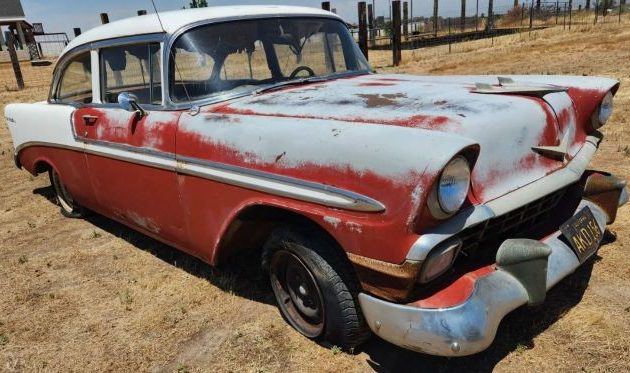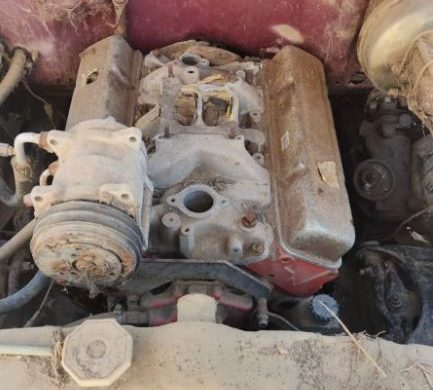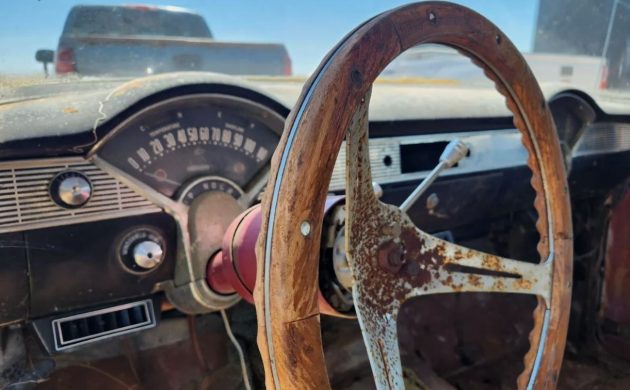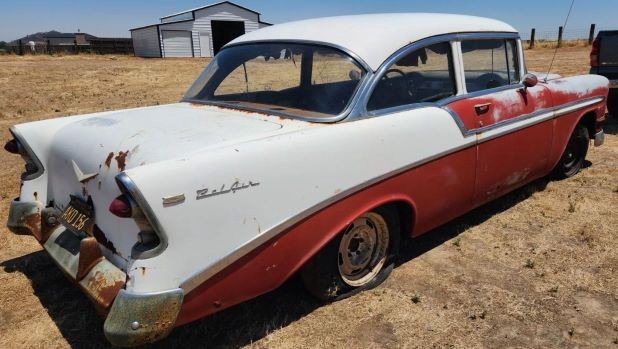The Chevrolet Bel Air is a textbook example of auto design evolution. From its awkward beginnings in 1950, plagued by leftover ’40s styling, to the prominent ponton fenders of 1952, the glamorous greenhouse of the ’55, and the batwing fins of ’59 – through the ages, the Bel Air has epitomized America’s fascination with fashion. This 1956 Bel Air is not feeling too fashionable, having been long-neglected in dry Madera, California. Its cabin has been relieved of most of its interior parts; the carburetor has also walked off. But remaining for our consideration is a fairly straight body with minimal rust, exterior trim, good glass, and a clean title.
Originally the Bel Air was a top trim level, differentiating it from the Styleline and Fleetline series. Quickly, it acquired its own sheet metal, grille, glass, and other distinctions, becoming a model in its own right. The first Bel Airs were equipped with in-line six-cylinder engines but by 1955, a V8 was available. The “Turbo Fire” 265 cu. in. V8 generates about 170 hp with a single-carb set-up; both a three-speed manual gearbox and Chevy’s two-speed Powerglide automatic were available. This Bel Air has the column-shift automatic. Performance was lauded back in the day, with journalists praising the car’s handling and acceleration. But original equipment doesn’t hold a candle to what’s possible today, from a complete mechanical swap, to rebuilding the original V8 to dual-quad PowerPak specifications.
A Bel Air’s interior is loaded with trim and accessories, and it’s built for comfort. Flashes of chrome decked the dash, though this example will need doctoring in that department. This steering wheel is not original – the Bel Air sported a horn ring, which was considered a luxe option when this car was built. Stainless trim around the windows – taken for granted by the time the 60s rolled around – was another upgrade. These niceties in addition to two-tone paint and full-length exterior trim earned the Tri-Fives another nickname: the “Hot One”.
Fins were beginning to emerge, along with bullet-style tail lamps – a theme that eventually saturated car design front, rear, and even inside. Our seller is transparent about rust issues, as seen along the quarters and infecting the chrome bumpers. But restoring a Bel Air is a well-trod path, and we’ve seen plenty of worse examples than this one here on eBay, bid to $6600 with no reserve in play. Is this a project you would want to tackle?





Sold for $7,000.
Steve R
Many, many years ago, the wiring harness burned up in my ’55 210. Rather than trying to replace it, I pulled the 283 and 3 speed and found a perfect ’56 210 body, complete, in St. Pete for $70. That was a deal, even in those days.
Hot Rod Candidate?
NO! Put in a new motor, get new tires, and then drive it ‘as is’.
Honestly, $7,000 doesn’t seem that far out of line. It’s a hell of lot more reasonable than a lot of the other crap that has been showing up lately.
A dry California car????? Photos must be of a different car.
30yrs would get us back to 1995…..is that a Vintage Air kit on it ?